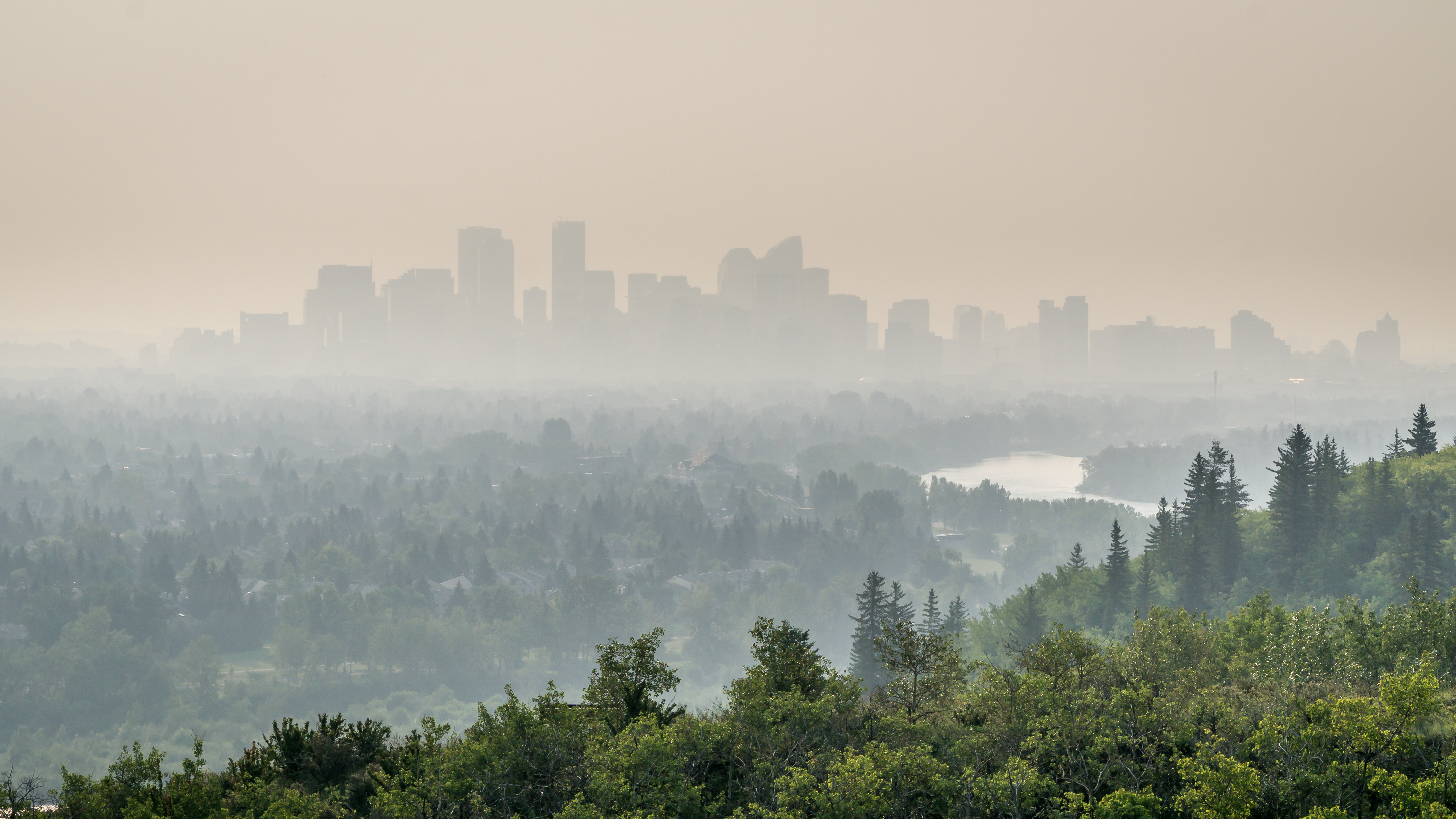Introduction to Air Quality

Air is one of the foundational substances the human body needs to survive and thrive. Clean air keeps us healthy and feels good to breathe in.
In an industrialized society, however, our air is always at risk of being polluted — whether it's your home’s interior air or the air outside. In fact, the American Lung Association found in its 2021 State of the Air Report that nearly 40% of Americans live in an area with unhealthy levels of pollution in the air. That’s over 135 million Americans whose health may be compromised (now or down the road) due to bad air.
Most of us know the obvious importance of clean air to our health and society, but you may not be too familiar with the subject of air quality itself. That said, the more educated you are about air quality, the better decisions you can make in a variety of areas. To keep you informed, we’ve created this introductory guide to air quality.
What is Air Quality?
Air quality tells you how much pollution is in the air. You can measure the air quality of both interior spaces and the outdoors.
- Indoors: How polluted your indoor air is due to things like toxic chemicals in building materials or biological pollutants like mold.
- Outdoors: The pollution levels of the air outside. Used to measure air pollution in locales, cities, states, and countries.
Why Does Air Quality Matter?
As mentioned, air quality measures what kind of pollutants and how much of each is in the air you breathe. Poor air quality can lead to or contribute to all sorts of health problems - especially in groups sensitive to air pollutants - such as:
- Respiratory issues
- Cardiovascular dysfunction
- Reduced cognitive function
- Some cancers
Thus, air quality is a crucial consideration for many in these groups, as well as healthy individuals who want to minimize the chances anything in their body suffers harm.
Additionally, poor air quality can harm the economy in several ways, including but not limited to:
- Medical costs associated with poor air quality
- The human cost - deaths due to poor air quality
- Productivity losses
- Pollution remediation costs
- Negative food production impacts
Indoor air quality is especially critical. Americans spend nearly 90% of their time indoors on average, according to the EPA. If you spend much more time inside your home, you’re breathing in much more interior air.
That said, outdoor air quality remains an important factor in choosing a place to live, especially for those with respiratory issues.
Measuring Air Quality
What Does Air Quality Actually Measure?
Air quality measures the amount of pollution in the air, both in total and by the types of pollutants. There are two primary types of pollutants it looks at:
- Ozone: Created when sunlight mixes with chemical emissions, such as carbon monoxide and methane.
- Particulates: Airborne solid particles or liquid droplets. such as pollen, viruses, and lead dust.
Within the particulate category, you have chemical and biological pollutants. Chemical pollutants include things like:
- Lead
- Asbestos
- Volatile organic compounds (VOCs)
As for biological pollutants, they can include:
- Mold and mildew
- Pollen
- Insects
- Viruses and bacteria
- Animal dander
Neither of those is an exhaustive list.

In the US, the Environmental Protection Agency (EPA) is responsible for measuring air quality, and they rely on numerous satellites and advanced ground-based tools to measure and report on it. Many other organizations, such as the American Lung Association, also report on air quality in various ways.
How is Air Quality Measured?
Air quality is measured using the EPA-developed Air Quality Index, or AQI. The AQI ranges from 0-500 and is divided into six categories, ranging from Good to Hazardous, as seen in the table below.
Read more here: https://blog.medifyair.com/air-quality-what-does-it-measure-and-how-do-you-measure-it.
What is Considered a Healthy Air Quality Rating?
Per the table above, anything 100 or below is considered to be satisfactory. Ideally, you want Good air quality, but Moderate will do, especially if you have no conditions that would make you sensitive to air pollution. Once you climb above 100, detrimental effects can start to appear in sensitive groups.
For ozone pollution, sensitive groups include the elderly, children, and people with lung disease or issues. Those same groups are sensitive to particulate pollution, along with people who are dealing with heart disease.
As air quality worsens and pushes past 150, healthy individuals without any conditions that may make them sensitive to air quality may also begin to experience the effects. They may be minor at first, but as air quality climbs into the 200s and higher, it becomes a great risk to their health.
The AQI applies to indoor air quality, too. Fortunately, there are plenty of electronic air quality monitoring devices. Some list pollution in mg/m3 or PPM, but others use the AQI for your convenience.
What Factors Can Lower Air Quality?
Air quality comes down to pollution levels, but various factors can impact those levels of pollution. Let’s look at a non-exhaustive list of factors that can lower air quality:
- Heat: Heat along with sunshine turns vehicle and industrial emissions into ozone. Grass also pollinates when it's hot outside, increasing particle pollution.
- Bugs: Several types of bugs, such as cockroaches, can worsen air quality.
- Humidity: Mold, mildew, and dust mites love moist environments. Each of these can trigger allergy issues and even possible health problems. At the same time, dry days can lead to more pollen in the air.
- Wind: Wind can spread both ozone and particulates throughout an area, worsening air quality all around.
- High-traffic or industrial areas: Fossil fuel power plants, factories, and vehicles all pump gases into the air that eventually becomes ozone.
- Insufficient air filtering: There are plenty of pollutants indoors, but they're generally only a worry if you don't have a high-quality air filter that cleans them out.
Many of these can make allergies worse. However, those with sensitivities may face worse health issues.
The Best and Worst States for Air Quality
There is much to consider when it comes to choosing a place to live. If you or someone in your family is in one of the aforementioned sensitive groups, air quality may be one of the more important matters to consider if you’re moving. It may even be a reason you move from your current location if it’s bad enough.
Various factors can impact outdoor air quality, from industry to weather and more. Consequently, each state has a different overall air quality rating. Even within those states, some cities do much better than others in terms of air pollution. Sometimes, a single city or area of the state may be known for poor air quality, whereas the rest of it isn’t too bad.
Regardless, let’s look at the best five and worst five states for air quality, based on the American Lung Association’s (ALA) State of the Air 2021 report.
The best states:
Here are some of the best states for air quality.
- Maine: Maine consistently has some of the best air quality, with most counties falling very low on the AQI index. Bangor isn’t on the 2021 list of cleanest cities, but only because of incomplete data. It usually is one of the cities with the cleanest air.
- Hawaii: Hawaii is far from the mainland US and isn’t exactly an industrial center, helping it be one of the best states for air quality. Urban Honolulu was ranked as one of the cleanest cities in the US by the American Lung Association.
- Alaska: Certain populous areas of Alaska, such as Fairbanks, have worse air quality due to wood-burning fires, but much of Alaska’s air has little pollution.
- Washington: Washington faces pollution from vehicles, wood smoke, and wildfires, but much of the state falls into the “Good” level of AQI.
- Oregon: Just south of Washington, Oregon also does pretty well with air quality. It averaged 38 AQI across its cities in 2018.
The worst states
Here are some states with the worst air quality.
- California: Los Angeles continues to be one of the worst cities in the US for air pollution. The smog that forms from vehicle pollution baking in the hot SoCal sun is a significant driver behind this.
- Texas: Texas air quality is poor in some areas due to the state’s oil and natural gas industries. Traffic in large metros and cities like Dallas-Fort Worth may make those cities even worse.
- Arizona: A lot of rural Arizona is fine, but Phoenix made ALA’s most polluted cities (in terms of air quality) across all three categories in 2021. Heat sunlight traffic plays a big role, here.
- Utah: Utah’s pollution may be partially attributable to mountains, which can lead to pollutants to concentrate in or disperse from an area. Still, they’ve taken actions to improve air quality.
- West Virginia: West Virginia is a center for the coal industry. Emissions from this industry lead to a significant amount of pollution in the air in various areas.
Read more here: https://blog.medifyair.com/the-best-and-worst-states-for-air-quality-ranked
Air Pollutants in Your Old Home
Older homes have a certain charm to them. However, If you have an older home, you’re likely exposed to toxic chemical pollutants in the air that render any good feelings about your home rather pointless. Homebuilders in the past used products containing all sorts of chemicals we now know to be health-hazardous. Additionally, there are biological pollutants to worry about.
Let’s look at some of the pollutants that may be floating around inside your old home.
- Lead: Lead was used in old paints. Lead paint becomes dangerous when it chips and releases led dust into the air.
- Formaldehyde: Found in flooring, furniture, and fabric. The EPA has classified it as a "probable human carcinogen."
- Mold and mildew: Old houses may have hidden mold and mildew that contributes to an unpleasant odor and poses health risks.
- Asbestos: Asbestos was used extensively in building materials, but it can contribute to lung disease and mesothelioma if it gets into your body.
Asbestos is among the most common hazardous building materials found in old homes. Before we discovered asbestos was dangerous, It was used extensively due to its heat and corrosion resistance, among other construction benefits. You can often find it in or around walls, ceiling tiles, insulation, pipes, and more.
Asbestos-related diseases can take a few decades to appear, meaning you may not be aware that the air you breathe is slowly making you sick. Experts can test asbestos levels to tell you for sure, but it's wise to get an air purifier as an extra layer of protection.
Air Pollutants in Your New Home
If you live in a brand new home, asbestos and lead may not be threats. However, a different set of chemical pollutants called volatile organic chemicals (VOCs) might. VOCs are essentially any harmful chemicals that have a high vapor pressure at room temperature, which causes them to become airborne. These can lead to respiratory irritation or worse in sensitive individuals.
Here are some things of your new home that may give off VOCs:
- Flooring, rugs, and adhesives: Each of these items contains materials that may give off VOCs.
- Paint: Your paint may not be lead-based, but the fumes can still be harmful, especially to young children, pregnant women, and pets.
- Caulk and sealants: The same substances that give these products flexibility may also release VOCs into the air.
- Cleaning products: Cleaning chemicals, from stronger substances like bleach to your window cleaner can evaporate into the air and cause irritation or harm. Soap, water, and baking soda can partially replace these products in some cases.
Fortunately, you might be able to find lower-VOC versions of each of these products if you shop around. When combined with an air purifier, you can enjoy that new home smell more safely.
Water Damage: A Threat to Your Home's Air Quality
Perhaps the most prominent biological pollutants many homes deal with are mold and mildew. These release spores into the air that can harm your respiratory system and exacerbate any conditions you might have. Long-term exposure can even be deadly.
These grow in areas that become wet or humid — such as basements and bathrooms — making water damage in the home a common cause for mold growth. Plumbing problems are a frequent reason for water damage in the home, but heavy storms and rainfalls can cause it as well.
Unfortunately, mold can grow in a wet area in as little as two days — and growth rates can increase much more after that.
The EPA recommends an N-95 mask, goggles, and protective equipment when cleaning up mold. Also, you should clean the mold completely before occupying the home. You can also hire a mold remediation company to do this for you. A good air purifier can help out for the time being while the mold is removed.
Can't Indoor Plants Improve Your Home's Air Quality?
Indoor plants offer beauty for your home's interior, and they can also reduce stress and anxiety. You may think they clean your interior air, but not exactly.
In 1989, NASA found that plants do purify the air under laboratory conditions. However, various experts have stated that these results don't carry over well to the real world. The effect your indoor plants have on air quality is negligible.
So you can enjoy the presence and aesthetics of your indoor plants, but if you want to get something that has a noticeable effect on air quality, an air purifier would be a wise choice.
Air Quality: Vital To Your Health
Air quality isn’t something many think about, but it has a significant impact on the health of you and your family as well as the economy and country at large. You may not be able to control the air quality outside — but you can take control of your indoor air quality. By doing so, you can ensure you and your family stay safe and healthy indoors. Download our free Clean Air Checklist to guide you in creating cleaner and safer air inside your home.


